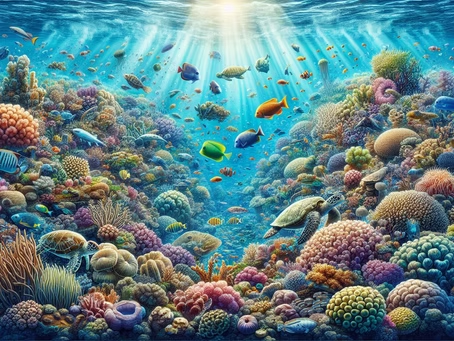The Importance of Coral Reefs
Often called the rainforests of the sea, coral reefs are essential for marine biodiversity and human livelihoods. They provide shelter for countless species, support global fisheries, generate billions in tourism revenue, and act as natural barriers protecting coastal communities. Despite covering less than 1% of the ocean floor, reefs sustain more than 25% of all marine life, making their preservation a global priority.
Biodiversity and Ecosystem Services
Home to Diverse Marine Life
- Colorful reef fish and schools darting through coral formations
- Invertebrates such as sea slugs, octopuses, and crabs
- Large predators like sharks and rays that balance ecosystems
Each reef is a living network where the loss of a single species can create ripple effects across the entire system.
Nurseries for Young Fish
Reefs act as nurseries for juvenile fish, offering food and protection from predators. Without these safe havens, many fish populations would struggle to replenish, undermining global fisheries and marine food security.
The Growing Threats to Coral Reefs
Climate Change and Ocean Acidification
Rising carbon dioxide levels increase ocean acidity, weakening coral skeletons and reducing growth rates. Warmer waters trigger mass bleaching events, stripping corals of the symbiotic algae they need to survive.
Overfishing and Destructive Practices
- Bycatch kills non-target species crucial for reef health.
- Dynamite and cyanide fishing destroy reef structures.
- Imbalanced predator-prey relationships reduce ecosystem resilience.
Pollution and Its Deadly Impact
Plastics, chemical runoff, and sewage smother corals, decrease water quality, and spread disease. Microplastics are especially harmful as they infiltrate food chains, threatening both marine life and human health.
Coral Bleaching: A Warning Sign
Understanding the Process
When stressed, corals expel their algae, leaving behind ghostly white skeletons. Prolonged bleaching often results in mass coral death and ecosystem collapse.
Rising Sea Temperatures
Even small, sustained increases in ocean temperature can trigger widespread bleaching, making reefs more vulnerable to disease and reducing biodiversity.
Recovery Potential
Reefs can recover if stressors are reduced, waters cool, and pollution is minimized. However, recovery often takes years and requires stable conditions.
The Economic Value of Reefs
Fisheries and Tourism
- Millions rely on reef fisheries for protein and income.
- Tourism generates billions annually from diving, snorkeling, and coastal activities.
Natural Coastal Protection
Reefs act as breakwaters, reducing erosion and protecting shorelines from storm surges, saving billions in potential damages.
Global Conservation Efforts
Marine Protected Areas
MPAs safeguard biodiversity by limiting harmful activities, helping reefs regenerate and serving as living laboratories for scientists.
Restoration Projects
- Coral gardening and biorock technology accelerate growth.
- Community-led programs restore reefs while promoting sustainable fishing.
- Educational initiatives raise awareness and build local stewardship.
Sustainable Tourism and Community Action
Eco-Friendly Tourism
Using reef-safe sunscreen, avoiding contact with corals, and supporting certified operators minimize tourist impact.
Community Engagement
- Local beach cleanups reduce pollution.
- Workshops promote sustainable fishing practices.
- Citizen science projects monitor reef health.
Innovation and Research
Technology in Monitoring
Drones, satellites, and AI-powered sensors allow real-time tracking of reef conditions, helping conservationists act quickly.
Breakthroughs in Coral Cultivation
Micro-fragmentation and selective breeding techniques accelerate coral growth and increase resilience against rising temperatures and acidification.
The Future of Coral Reefs
Despite the challenges, reefs have shown resilience when given protection and time to recover. International cooperation, sustainable policies, and local involvement are critical. By reducing carbon emissions, curbing destructive practices, and supporting reef-friendly initiatives, we can ensure coral reefs continue to thrive as vital ecosystems for generations to come.
Conclusion
Coral reefs are more than natural wonders; they are lifelines for marine biodiversity and human survival. Their future depends on our collective responsibility to reduce threats, embrace sustainable practices, and invest in science-driven solutions. Protecting coral reefs is not just an environmental duty—it is a global necessity.

